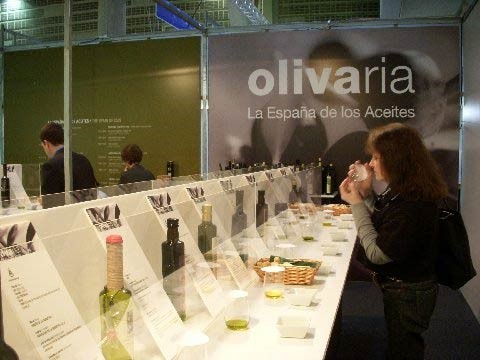The Fresh Press
Your Connection to Fresh-Pressed Olive Oil
Around the Globe
NAVIGATING THE OLEUM FLUMEN
(THE RIVER OF olive OIL):
ALIMENTARIA ’08
Plus, Make a Spanish Tortilla for Supper Tonight
By Nancy Loseke
Filed: April 10, 2008
Until now, you couldn’t convince me those two years of Latin in seventh and eighth grade would ever pay off.
I simply could not, I thought, be justly compensated for memorizing “Paulus est puer” (Paul is a boy), for being publicly auctioned off at age 14 for $42 as a toga-clad “slave” for a weekend to upper-classmen and/or potentially predatory men in the community, or for catching my death of cold from mandated osculatory engagements with “masters” at the most infamous Latin Banquet my Midwestern public school ever sponsored in its fluorescent and disconcertingly well-lit cafeteria.
All in the name of replenishing the waning Latin Club coffers with pecunia.
The Club wasn’t in a position to tax amphorae of olive oil like the Romans did. So… Hey! Why not trade in virgins? It must’ve seemed like a good idea to someone at the time.
I’m obliged to say my Latin teacher--who has since passed, so I know I’m not embarrassing her--was a very nice person and a good instructor. She was found sobbing in the restroom that night. Official word was she got sick on improperly cooked pigeon. Uh-huh. And I got sick that weekend from improperly fermented garum. (Wink, wink.)
Recently, I found myself staring up at a gigantic billboard on the outskirts of Barcelona, Spain, with the word “ALIMENTARIA” spelled out in black letters 8-feet tall: Alimentaria, an alliterative, six-syllable, roller coaster ride of a word with deep Latin roots meaning “food or nourishment.”
How can a language be declared “dead”, I thought, when it can still produce little intellectual thrills in people who recognize it--even vaguely or intermittently?
I fervently believe the language survived its premature postmortem: Latin lives.
“Alimentaria,” one of the largest food and wine shows in the world, was the reason my colleague, T.J. Robinson, and I flew to Catalonia.
Last year, we logged more than 1000 miles in a rental car we picked up in Lisbon, Portugal, and drove, Man of La Mancha-like, all over the Iberian Plain, visiting individual producers in search of great olive oils. We were beat by the end of the trip, and even the computer-generated voice of our veddy British-sounding Global Positioning System was getting a bit testy. A GPS with PMS? Now that’s scary!
In the future, we decided, we were going to have to build some efficiencies into our modus operandi to maximize our olive oil exposure.
So we were very receptive a few weeks ago when one of our olive oil contacts, Isabella Alameda oilvares, told us about Alimentaria ’08, where we’d find Spain’s largest olive oil producers as well as many smaller family-run businesses and rural cooperatives in one place, the multi-roofed Gran Via exposition center on the outskirts of the city.
Alimentaria is the third largest food show in the world. It boasts over 1,400,000 square feet of exhibition space, a “wear comfortable shoes” venue if I’ve ever seen one. The event takes place over five days and is attended by over 150,000 people. In addition to olive oil, there were pavilions for meat, organic foods, restaurant-related products, cold and frozen foods, wine, canned foods, beverages, and cheese and other dairy.
Spain, people are often surprised to learn, produces between 40 and 50 per cent of the world’s olive oil, making it the largest producer on the planet. It has more than 300 million olive trees; the highest concentration is in Andalusia, in the south, where you can drive for hours and see only olive trees and the occasional 45-foot-tall cut-out silhouette, black and blank, of a bull (Toro de Osborne), reminding motorists Spain also produces sherry.
If you’ve ever bought supermarket olive oil--and who hasn’t?--chances are good that you have tasted Spanish olive oil. Historically, Spanish olive oils have been undervalued in the world marketplace, even in Spain itself, where olive oil is used profligately by home cooks and often purchased in five-liter plastic containers. Millions of gallons are exported to Italy each year where they are blended with oils (some of them chemically refined) from other countries and bottled for the retail market. Until this year, it was not illegal for Italian wholesalers to label these blends “Product of Italy.”
But I predict olive oil lovers around the globe will soon begin to appreciate the excellence of Spanish extra virgins. T.J. and I have certainly seen the light.
For several days, we did a protracted olive oil crawl in the cavernous pavilion known as “oilvaria,” only one small part of Alimentaria. Some of the displays were stunningly elaborate with green being the predominant color in these pre-fab olive oil emporiums.
Actually, we were feeling a bit green ourselves, having tasted more than 100 oils, retasting those of special interest at the olive oil bar, and consuming the equivalent of several cups each of olive oil. (For what it’s worth, my skin has never felt softer.) But a little Spanish jamon and a few chunks of bread always pulled us back from the brink of olive oil overdose.
It was such a privilege to attend Alimentaria. We got reacquainted with producers whose oils have consistently impressed us, and made many new contacts:
· Francisco “Paco” Vañó of Castillo de Canena, whose familial castle we toured last year, was justifiably proud of this year’s harvest of Arbequina and Picual. The first day’s harvest was, once again, bottled in designer bottles so beautiful that even the most earnest olive oil lover is loathe to open them;
· Jose Millán Valderrama, our genial host in Tolédo in 2007, was there with his Hojiblanca, Arbequina, Ocal, and an exceptionally food-friendly Picuda. He also introduced us to a novelty-olive oil-flavored gelees! (See photo.)

olive oil gelees were just one of
the olive oil-based novelties
seen and tasted at oilvaria.
· And speaking of novelties, Carlos Aldama Pascual, one of the first booths we visited, urged us to try not only his family’s wonderful olive oil, but chocolates with olive oil and sea salt centers;
· Though we were somewhat palate-fatigued by the time we tasted it, an Arbequina from Extremadura, Pago de Los Baldios de San Carlos was a stand-out;
· Marques de Griñon continues its ground-breaking experiments in producing high-quality olive oils while maximizing the oils’ healthy polyphenol levels (stay tuned!);
· The estate-bottled oils of Marques de Valdueza (I’d buy its Merula just for the arty, award-winning tin it comes in) always please;
· On the bottle, Oro Bailén’s Picual promises “Frutado Intenso,” and baby, it delivers.

Fresh Press Editor Nancy Loseke does another round at the olive oil tasting bar.
If you think ingesting all that olive oil would dull my appetite for tapas, those enticing savories Spaniards nibble before dinner with sherry, beer, or a Vinho Verde-like wine called Txacoil (chak-o-lee), you would be wrong.
In fact, in a future issue of Fresh Press, I’ll share recipes for some of my favorite bites from Barcelona. In the meantime, here’s a teaser:
SPANISH POTATO OMELET
(Tortilla a la Española)
Good hot or cold, this simple dish, usually cut into squares and skewered on toothpicks, is ubiquitous at Spanish tapas bars. (It is really more like a frittata than an omelet.) But it’s my go-to dish after a long trip when the cupboard is almost bare and the last thing I want to do is leave the house. Serve it as an appetizer with drinks, or cut it into wedges and eat it for breakfast, lunch, or a light dinner. If doing the latter, pair it with a green salad dressed with olive oil, Spanish sherry vinegar, and crunchy salt. Last night, I ate it with roasted asparagus, a great combination. This recipe is adapted from “Tapas: The Little Dishes of Spain” by Penelope Casas (Alfred A. Knopf, 2002).
- 1 cup olive oil
4 large potatoes, peeled, cut in quarters, and cut in 1/8-inch slices
1 large onion, diced
4 large eggs
Coarse salt (kosher or sea)
Strips of roasted red pepper or pimientos (optional)
Heat the oil in a medium nonstick skillet and add the potatoes slowly, spreading them out in the pan so they don’t stick together. Add the onions, making sure the vegetables are submersed in the oil. Simmer slowly over medium-low to medium heat (the potatoes and onions will really “boil” in the oil rather than fry), carefully lifting and turning the vegetables until they are tender, but not browned, about 20 minutes. The potatoes should remain separated, not clumped together in a “cake.”
Drain the potatoes and onions in a colander positioned over a bowl, reserving about 3 tablespoons of the oil. (The onion and potato give the oil a wonderful flavor, so save the rest for another use.) Let the potatoes and onions cool for several minutes. Wash the skillet.
Meanwhile, in a large bowl, beat the eggs with a whisk or fork with about 1/2 teaspoon of salt until they are slightly foamy. Fold the cooled potatoes and onions to the eggs, mixing gently so the vegetables are completely covered in egg. Press the mixture down with a pancake turner, and let it sit for 15 minutes.
When ready to cook the omelet, heat 2 tablespoons of the reserved oil in the skillet over medium-high heat. (The eggs will stick to the pan if the oil isn’t hot enough.) Add the potato and egg mixture, spreading it out evenly and rapidly in the skillet with the aid of a pancake turner. Lower the heat to medium and shake the pan often to prevent sticking. When the eggs just begin to brown underneath, invert a plate of the same size over the skillet and quickly flip the omelet onto the plate. (See Cook’s Note below.) Add the remaining tablespoon of olive oil to the pan, then slide the omelet back into the skillet to brown on the other side. Repeat one or two times, cooking briefly on each side. (This gives the omelet a more compact and uniform shape while it continues to cook.)
Transfer to a platter, cool slightly, and cut into wedges or 1-1/2 inch squares that can be picked up with toothpicks. If desired, position a red pepper strip on top and run the toothpick through that as well. May be prepared several hours ahead and held, covered, in the refrigerator.
Makes one tortilla, serving 8 to 10 as an appetizer, or 4 as a light meal.
Cook’s Note: This flipping of the omelet can be a little tricky, and I can tell you from experience that a little insecurity when performing the maneuver will almost guarantee a mess. So I have been known to start the omelet on the stovetop and transfer it to a 350 degree oven to finish cooking. Just make sure the handle of your skillet is ovenproof.
TRAVEL TIP
If you are cell phone dependent, it’s wise to take two telephone chargers with you, or even one of the self-contained battery-operated emergency chargers sold by companies such as Energizer. Keep one with you at all times. Chargers do fail, and can be impossible to replace if you are traveling overseas. Also remember to take a voltage converter and the correct adaptor plug, usually sold at luggage/travel shops, if traveling outside the U.S.
To subscribe to
Fresh Press and to get your free, instant online
bonus, "How to Shop for Olive Oil. " link to
www.TheOliveOilSecret.com.
Fresh Press
is a free E-Zine brought to you by:
The Olive Oil Secret
1854A Hendersonville Rd. #20
Asheville, NC 28803
E-mail
freshpress@theoliveoilsecret.com with questions